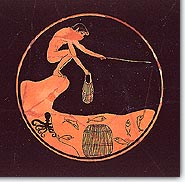

 |
|
|
|
|
 | The four classes envisaged by the Solonian legislature were not the lawgiver's own invention, but existed previously. But it was only at this time, the beginning of the 6th century B.C., that these classes acquired a clear economic contour on the basis of citizens' income and that both the relations between them and their obligations towards the body politic were defined. Social mobility, limited in the 7th century B.C., increased markedly during the 6th, mainly because of development in commercial activity. Aristotle (Athenaion Politeia 7.2-4) records one instance of a citizen moving up directly two classes in the social hierarchy; and this was probably not an isolated phenomenon. |
Around the mid-6th century B.C. three powerful social groups with different interests emerged. These groups, which were known as staseis and were, up to a point, an expression of citizen classes without coinciding absolutely with them, eventually came into conflict. They were: the old eupatrids of the plain, led by the Philaid family; the traders and fishermen of the coast, chiefly representing the middle classes and steered by the Alcmaeonids; and the hill villagers, who belonged to the two lowest classes and supported Pisistratus. The latter eventually prevailed, and set up a tyranny.
Cleisthenes' reforms led decisively from timocracy to democracy. Most of the offices in the body politic became accessible to any citizen, the only exceptions being those of archon and treasurer.
|
| |
|
Note: Click on a picture for a brief description. | |